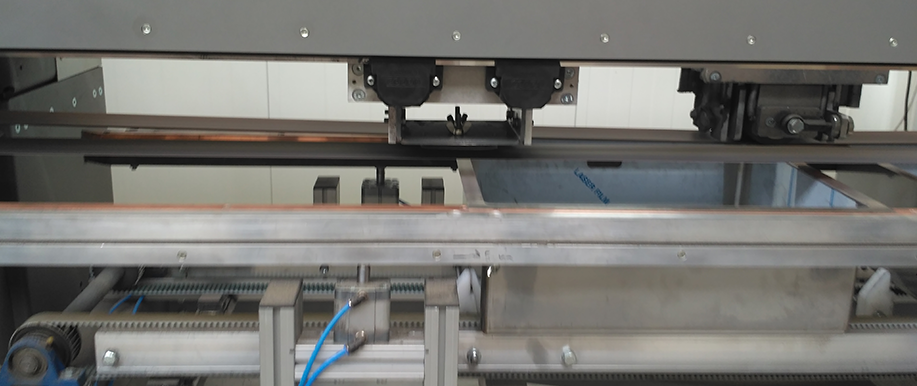Article classificationArticle
PRECISION GUIDANCE NEEDED FOR METALWORKING MACHINERY THAT AUTOMATICALLY GRINDS 40,000 SINKS EVERY YE
Peitzmeier Maschinenbau machine builders based in Germany specialise in the construction of grinding machines. Their latest invention, the Omni-Grind Twin 3100 AC, enables automated grinding and polishing of workpieces in the metalworking industry. The machine builder relies on HepcoMotion’s GV3 guidance to prevent damage to the steel during processing; the linear guide system enables precise alignment of the grinding tool in the range of hundredths of a millimetre.

The challenge: A major customer wants to precision grind 40,000 stainless steel sinks per year
Among the users of Peitzmeier’s grinding machines is a Dutch manufacturer, who processes stainless steel sinks for a Swiss company. The design of the grinding machine had some challenging requirements, as Ulrich Peitzmeier, Managing Director of Peitzmeier explains: “The three-ton plant needed to be capable of grinding 40,000 sinks per year with extra care – the sinks are made from sheet metal just one millimetre thick. If a tool takes too long grinding material in one place, it can very quickly damage the workpiece.”
Peitzmeier had to adapt their grinding machine to meet these requirements. The heavy grinding tool, usually mounted on a double-stranded U-rail, had to be replaced in favour of a lighter tool that could be aligned more precisely on just a single guide rail. The guidance system previously used by Peitzmeier in this machine was unsuitable and so Peitzmeier had to find an alternative supplier. Peitzmeier found what they were looking for with HepcoMotion – a company that has specialised in the development of linear guide systems and automation components since 1969.
HepcoMotion’s GV3 linear guides allow movement in the range of hundredths of a millimetre
Peitzmeier opted for Hepco’s core GV3 linear guidance system. “The system consists of precision ground guide rails and a carriage with V bearings,” explains Thorsten Pfau, Field Sales Manager at HepcoMotion Germany. “The bearings have a V-groove which fits on to the V shape of the running surfaces on the guide rail. These bearings allow low-friction movement at speeds of up to 8 metres per second.” Also the guide rails offer sufficient rigidity to withstand the contact pressure of the grinding tool: “We were looking for this exact combination of precision and resistance to deformation,” says Peitzmeier.

How the grinder works
Three sinks are moved onto a processing table via a conveyor belt and then clamped in position with pneumatic cylinders. The sinks are then moved to the grinding belt, which moves in a trapezoidal circulation system. The grinding tool (which moves horizontally on the guide system, between the feet of the machine) presses an abrasive belt on to the surface of the workpiece using a roller, so that it achieves the desired grinding effect. The ability to precisely adjust the grinding tool ensures that the machine never grinds for too long in a single position. Behind the grinding tool, a polishing tool is mounted to a second guide rail. The stainless-steel wash-basins can then be polished to a high gloss.
A further consideration in this application is the need for the guide to withstand contamination arising from the grinding process. This is where Hepco’s GV3 comes in. Hepco’s V guide system effectively addresses the problem of debris entering the sliding mechanisms thanks to its self-cleaning action, ensuring a smooth and accurate grind. Having invented the V guide system nearly 50 years ago, Hepco is well renowned for its V guide technology and the many benefits it offers.
Award-winning: The Omni-Grind receives second place in the Innovation award category the Euroblech Exhibition 2016
Peitzmeier has already achieved success with the Omni-Grind. At the Euroblech exhibition in 2016, the company won second place in the Innovation Award. What makes the grinding machine so special? Not only its precision but also its modular design. “Many customers initially buy a reasonably priced base machine, where the grinding table and tool are controlled manually. After some time, they want to increase productivity and invest in an automatic grinding tool, a turn/tilt unit and a new controller. As the machine is modular, it is possible to upgrade to a fully automated system without having to replace the full machine.” explains Peitzmeier. Laser production makes modularity particularly economical: “We manufacture the complete machine from laser-cut components. Unlike castings and welded constructions, all fixing surfaces and holes can be integrated directly into the base machine, with little effort. “For example, a second guide rail can easily be mounted to the machine for a de-burring module, a rounding module or a polishing head.”
“We have found a linear guide system that is precise, durable and space-saving. These factors are all crucial in mechanical and plant engineering. Our fitters were also enthusiastic about the time-saving installation of the guidance system.”